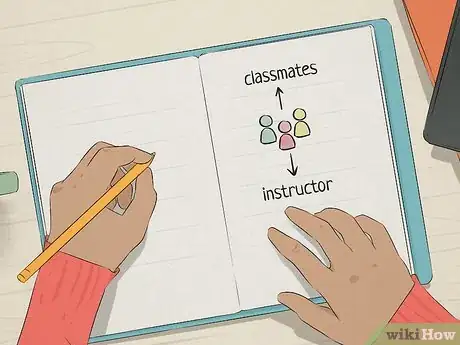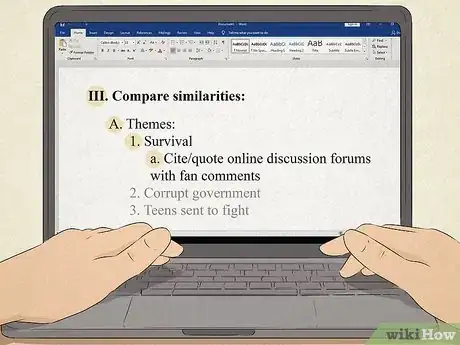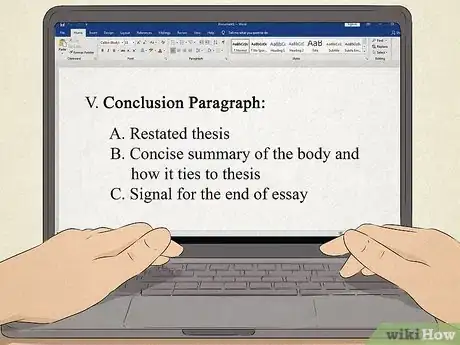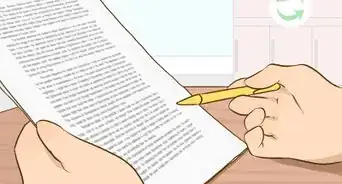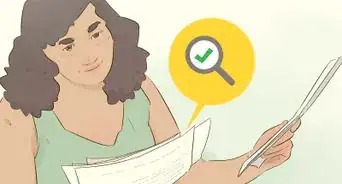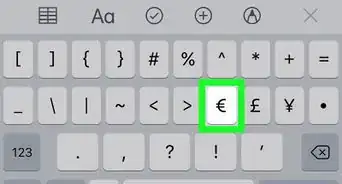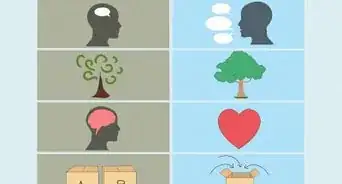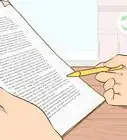This article was co-authored by Jake Adams. Jake Adams is an academic tutor and the owner of Simplifi EDU, a Santa Monica, California based online tutoring business offering learning resources and online tutors for academic subjects K-College, SAT & ACT prep, and college admissions applications. With over 14 years of professional tutoring experience, Jake is dedicated to providing his clients the very best online tutoring experience and access to a network of excellent undergraduate and graduate-level tutors from top colleges all over the nation. Jake holds a BS in International Business and Marketing from Pepperdine University.
There are 10 references cited in this article, which can be found at the bottom of the page.
wikiHow marks an article as reader-approved once it receives enough positive feedback. This article received 19 testimonials and 90% of readers who voted found it helpful, earning it our reader-approved status.
This article has been viewed 541,738 times.
Essay outlines provide structure and guidance for writers as they begin the drafting process. An outline should briefly summarize the intended content of your essay and organize that content in a sensible, coherent manner. Knowing how to outline is an important skill for students, since some instructors require students to turn in outlines before submitting their papers. Keep reading to learn more about how to develop an effective outline for your paper.
Steps
Preparing to Outline a Paper
-
1Read the assignment guidelines carefully. Highlight or underline important words and phrases in the instructions. Make sure that you fully understand what the instructor is asking you to do before you begin your outline. Ask for clarification if anything seems vague or confusing.
-
2Develop a topic. Although outlining a paper can help you to develop and organize your ideas, you may need to do some other prewriting exercises to get started.[1] There are many useful prewriting strategies that can help you to generate ideas for your paper.
- List all the ideas that come to mind (good or bad) and then look over the list you have made and group similar ideas together. Expand those lists by adding onto the list or by using another prewriting activity. [2]
- Freewriting. Write nonstop for about 5-10 minutes. Write whatever comes to mind and don’t edit yourself. When you are done, review what you have written and highlight or underline the most useful information. Repeat the freewriting exercise using this information as a starting point. You can repeat this exercise multiple times to continue to refine and develop your ideas. [3]
- Clustering. Write your subject down on the center of a piece of paper and circle it. Then draw three or more lines extending from the circle. At the end of each of the lines you have drawn, write down a new idea that corresponds to your main idea. Then draw three or more lines from each of those new ideas, and write ideas that corresponds to those ideas. Continue developing your cluster until you feel that you have explored as many connections as you can. [4]
- Questioning. On a piece of paper, write out “Who? What? When? Where? Why? How?” Space the questions about two or three lines apart so that you can write your answers on these lines. Respond to each questions in as much detail as you can. This exercise will help develop your ideas and identify areas of your topic that you need to learn more about. [5]
Advertisement -
3Identify your purpose. Ask yourself what you want to accomplish with your paper. Are you writing this paper in order to persuade, entertain, enlighten, or something else? Just make sure that your purpose is in line with what the assignment asks you to do. Look for keywords in the assignment guidelines to help you figure out what your purpose should be.[6]
-
4Identify your audience. Think about who will read your paper. Your instructor? classmates? strangers? Identify the needs and expectations of your audience by considering what they do and do not know about your topic. Anticipate their reactions as well. How they might react to the information that you will be sharing with them? Will they be angry, sad, amused, or something else?[7]
-
5Develop your thesis. Once you have developed your ideas and considered your purpose and audience, you should be ready to write a thesis statement. Effective thesis statements express the main focus of a paper and state an arguable claim. A thesis should not be more than one sentence in length.[8]
- Make sure your thesis is arguable. Do not state facts or matters of taste. For example, something like "George Washington was the first president of the United States," would not be a good thesis because it states a fact. Likewise, "Die Hard is a great movie," would not work because it expresses a matter of taste.[9]
- Make sure your thesis provides enough detail. In other words, avoid simply saying that something is "good" or "effective" and say what specifically makes it "good" or "effective."[10]
Deciding on a Basic Outline Structure and Style
-
1Choose a standard alphanumeric structure for an easy outline structure. An alphanumeric outline is the most common, easily recognized outline type, and each subdivision is identified by Roman numerals, capitalized letters, Arabic numerals, and lowercase letters, in that order.[11]
- Roman numerals (I, II, III, etc,) are used to mark each major heading or section. You will typically have three for an essay outline: one for your introduction, one for your body, and one for your conclusion.
- Capitalized letters (A,B,C, etc.) mark each primary point within a major section.
- Arabic numerals (1, 2, 3, etc.) are used to flesh out primary points.
- Lowercase letters (a, b, c, etc.) are used if further detail is still required.
-
2Choose a decimal outline structure to show how your ideas are related. A decimal outline is similar in structure to an alphanumeric outline, but it only uses a series of numbers to identify each subsection. Some people prefer this structure because it shows how each section contributes to the essay as a whole. [12]
- A decimal outline begins with “1.0” and other sections will begin with different numbers (2, 3, 4, etc.). Therefore, the first section would read "1.0," the second would read "2.0," and the third would read "3.0."
- The number after the decimal point changes when new information is presented. For instance, under the "1.0" section, you would expect to see "1.1," "1.2," and so on.
- Further subsections can be added by adding another decimal, followed by a number that corresponds to the new information. For instance, under the first "1.1" section, you might find "1.1.1," "1.1.2," and "1.1.3" labels.
-
3Determine whether to use full sentences or brief phrases in your outline. For most outline essays, full sentences will prove more useful because they allow you to provide more thorough information.[13] This is especially true if your outline must be handed in to an instructor.
-
4Use parallel structures for outline sections. For example, if one section of your outline begins with a verb that uses the present tense, then the next section should also begin with a verb that uses present tense. [14]
- For example, if section I of your outline begins with something like “buying a new book,” then section two should begin with a similarly structured phrase. Something like “reading my new book” would be appropriate whereas “read my new book” would not be appropriate.
-
5Coordinate section titles and subordinate subsections. Each section title should feature information that is equally important to other section titles and subsections should contain information that is less important than your main section titles.
- For example, if you are writing a narrative essay about discovering and reading your favorite book and the first section of your outline is titled “Hearing about the book,” then “Checking the book out of the library” and “Reading the book” would be appropriate titles for the other sections of your essay outline. These outline section titles feature information that is as important as the first section title. However, titling a section something like “went to my room and closed the door” would not be appropriate. This line would work better as a subsection under “Reading the book.”
-
6Divide each heading into two or more parts. In order to provide adequate information for each section, you will need to divide each section into two or more parts.[15]
- For example, under the section heading “Hearing about the book,” you might also include subsections called “talking to my best friend,” “listening to the radio on my way to school” and “browsing the internet for new book ideas.” Beneath each of these subsections you would provide additional sub-subsections to break down the information that you will need to include in each of these subsections.
Organizing the Information in Your Essay Outline
-
1Provide your introduction in the first section of your outline. This section should include an attention getting opening and general information about your topic. The information you provide in your introduction outline should gradually become more specific as you progress through its subsections. The last subsection of your introduction outline should be your thesis statement.[16]
- Under the first sub-point, write a sentence that introduces the essay topic while also grabbing the reader's attention. A shocking fact or anecdote is a great way to start.
- The second sub-point should describe the topic, history of the issue, background, or problem being explored. Keep this section brief, but include the information that your readers will need to know in order to understand your paper.
- The final sub-point should be your thesis statement. State the idea or argument that you plan to discuss in your essay.
-
2Provide essay body information in the second section of your outline. The body of your essay should be the largest part of your essay, so you will want to devote at least three subsections to this portion of your outline.[17]
- Do not label each point as "main point." Instead, directly write out the point being explored.
- Under each main point, you should write supporting evidence to back the point up. Give each piece of supporting evidence its own line and sub-section. Then, write out an explanation analyzing the evidence and showing how it supports your claims.
- If desired, you could also include a sentence that transitions into your next major point at the end of each "main idea" section. This is not strictly necessary, though.
-
3Provide your conclusion information in the last section of your essay outline. This section should return the reader to the general discussion brought up in the "introduction" portion.[18]
- Restate your thesis first. Do not copy your original thesis statement word-for-word. Instead, restate the idea, but rephrase it in a new way.
- Make a concluding statement. A concluding statement will usually discuss the implications of the thesis, propose solutions to problems addressed in the essay, or explain the importance of the thesis to something outside of the range of the essay.
-
4Check your work against your assignment sheet, if applicable. If you're writing your outline to fulfill an assignment, you should always go back over your assignment sheet or rubric to make sure you fulfilled all of the requirements. Double check that your work completely satisfies your instructor's expectations so you'll get full credit!
Expert Q&A
Did you know you can get expert answers for this article?
Unlock expert answers by supporting wikiHow
-
QuestionHow long should I outline my essay?
 Jake AdamsJake Adams is an academic tutor and the owner of Simplifi EDU, a Santa Monica, California based online tutoring business offering learning resources and online tutors for academic subjects K-College, SAT & ACT prep, and college admissions applications. With over 14 years of professional tutoring experience, Jake is dedicated to providing his clients the very best online tutoring experience and access to a network of excellent undergraduate and graduate-level tutors from top colleges all over the nation. Jake holds a BS in International Business and Marketing from Pepperdine University.
Jake AdamsJake Adams is an academic tutor and the owner of Simplifi EDU, a Santa Monica, California based online tutoring business offering learning resources and online tutors for academic subjects K-College, SAT & ACT prep, and college admissions applications. With over 14 years of professional tutoring experience, Jake is dedicated to providing his clients the very best online tutoring experience and access to a network of excellent undergraduate and graduate-level tutors from top colleges all over the nation. Jake holds a BS in International Business and Marketing from Pepperdine University.
Academic Tutor & Test Prep Specialist
-
QuestionWhat is an outline used for?
 Emily Listmann, MAEmily Listmann is a private tutor in San Carlos, California. She has worked as a Social Studies Teacher, Curriculum Coordinator, and an SAT Prep Teacher. She received her MA in Education from the Stanford Graduate School of Education in 2014.
Emily Listmann, MAEmily Listmann is a private tutor in San Carlos, California. She has worked as a Social Studies Teacher, Curriculum Coordinator, and an SAT Prep Teacher. She received her MA in Education from the Stanford Graduate School of Education in 2014.
Test Prep Tutor
-
QuestionWhat is the difference between an outline and a structure?
 Community AnswerThe structure is the frame on which to build your outline: Intro, Body 1, Body 2, Body 3, and Conclusion is a structure. Your outline fills in the structure. Use the Intro to state your topic and let your reader know what you'll be discussing. The body paragraphs go into detail on each of your points, and the conclusion sums up and reiterates your points.
Community AnswerThe structure is the frame on which to build your outline: Intro, Body 1, Body 2, Body 3, and Conclusion is a structure. Your outline fills in the structure. Use the Intro to state your topic and let your reader know what you'll be discussing. The body paragraphs go into detail on each of your points, and the conclusion sums up and reiterates your points.
References
- ↑ https://www.csueastbay.edu/scaa/files/docs/student-handouts/prewrite-exercises-beverett.pdf
- ↑ http://writing.ku.edu/prewriting-strategies
- ↑ http://writing.ku.edu/prewriting-strategies
- ↑ http://writing.ku.edu/prewriting-strategies
- ↑ http://writing.ku.edu/prewriting-strategies
- ↑ https://academicguides.waldenu.edu/writingcenter/writingprocess/outlining
- ↑ https://writingcenter.unc.edu/tips-and-tools/audience/
- ↑ http://writingcenter.unc.edu/handouts/thesis-statements/
- ↑ http://writingcenter.unc.edu/handouts/thesis-statements/
- ↑ http://writingcenter.unc.edu/handouts/thesis-statements/
- ↑ https://owl.purdue.edu/owl/general_writing/the_writing_process/developing_an_outline/types_of_outlines.html
- ↑ https://owl.purdue.edu/owl/general_writing/the_writing_process/developing_an_outline/types_of_outlines.html
- ↑ https://owl.purdue.edu/owl/general_writing/the_writing_process/developing_an_outline/types_of_outlines.html
- ↑ https://owl.purdue.edu/owl/general_writing/mechanics/parallel_structure.html
- ↑ https://apastyle.apa.org/style-grammar-guidelines/paper-format/headings
- ↑ https://www.grammarly.com/blog/essay-outline/
- ↑ https://www.grammarly.com/blog/essay-outline/
- ↑ https://academicguides.waldenu.edu/writingcenter/writingprocess/outlining
- ↑ Jake Adams. Academic Tutor & Test Prep Specialist. Expert Interview. 20 May 2020.
About This Article
To write an essay outline, start with a section about your introduction that includes an introductory sentence and your thesis statement. Then, make a section about the body of your essay that has subsections for each paragraph you'll be writing. Within each subsection, include the main point of the paragraph and any evidence you'll be presenting to support it. Finally, create a section about your essay's conclusion that includes a final sentence. For help choosing between a numeric or decimal outline structure, keep reading!



